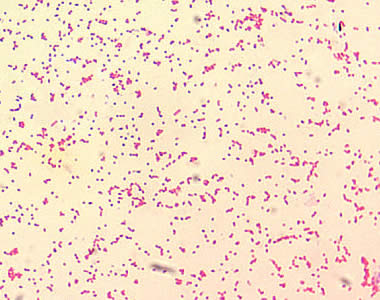Infectious Diseases Case of the Month #4 |
|||
 |
A 27 y.o. white female was seen in infectoius diseases clinic for a 4 week history of fevers, chills, sweats, and a five to ten pound weight loss. She denied localizing symptoms including cough, rash, abdominal pain, vomiting, joint pain, or dysuria. Examination was largely benign although there was moderate tenderness in the epigastrium and left upper quadrant of her abdomen. A native of Mexico, she was married and had lived in North Central Washington for the previous ten years. Other family members were not ill. Five or six months prior to her illness she had undergone a Billroth Type I partial gastrectomy for gastric adenocarcinoma. This surgery was performed in Mexico and she convalesced there until her return two months prior to the onset of her current illness. While convalescing in Mexico she consumed quite a bit of cheese; she was unsure as to whether it was pasteurized. Laboratory evaluation included WBC 4.3 (L), Hgb 11.2 (L), Plts 247, Alk Phos 141 (H), AST 55 (H), T Bili 0.4. CT scans of abd and chest were notable only for post gastrectomy changes. Two blood cultures became positive after four to five days of incubation. Gram stain of organisms cultured from blood was similar to the one pictured at left. |
||
What bacterium is the most likely cause of her illness? |
|||
 |
This patient was bacteremic with Brucella melitensis possibly acquired during her convalescence from gastric surgery while she was in Mexico. Several of the other bacteria in the previous list could have caused a prolonged febrile illness, particularly Salmonella and Listeria. However, the gram stain was most consistent with Brucella given the organisms' faint staining and coco-bacillary form. In contrast, Listeria are gram positive rods while Salmonella, Shigella, and Yersinia are more typical gram negative rods (rather than coco-bacillary). In the case described identity of the infecting organism was confirmed at the CDC. The patient had a total of six positive blood cultures over a ten day period. An echocardiogram did not suggest endocarditis. The patient received six weeks of therapy with doxycycline and rifampin and and appeared to recover completely. Brucellosis is a zoonotic disease that occurs rarely in the United States (reported cases 0.04 per 100,000 population). Those persons at greatest risk are those who work with infected animals or their tissues and those who consume raw milk and milk products. Brucella species are also pathogens of considerable veterinary importance where they can cause spontaneous abortion and chronic infection. Concern about spread of brucellosis (Brucella abortus) to cattle, for example, led to authorized killing of bison near Yellowstone Park in recent years. In humans brucellosis is a systemic disease usually characterized by an acute or insidious onset of flu-like symptoms. The incubation period is variable (5-60 days) and complications can occur, particularly osteoarticular. Case fatality rate in the U.S. is 2% with fatalities usually from endocarditis. Illness and fever can be relapsing or remittent and thus the disease is also known by an older descriptive term, "undulant fever."
|
||
| Home Case of the Month ID Case Archive | Your Comments/Feedback | ||